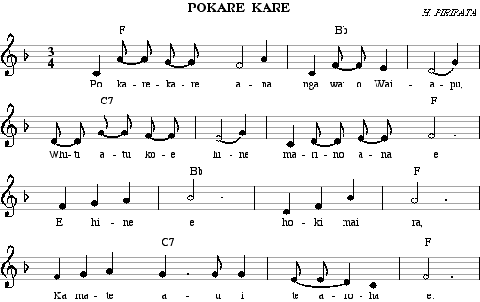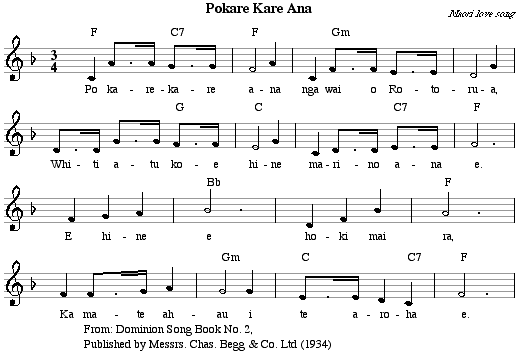World
War One
- Te
Aute College 1913
- Hokianga
1915
- Narrowneck
Camp
- Torere
- Ruatoria
- many
casualties
Early performances
A Dalmatian folk song in 1914?
In 2006 Paul Ward, a writer for a TVNZ
documentary on the Dalmatians settlers in
Northland's Puhoi area wrote, "I've
heard anecdotally from a number of people that
we've interviewed that the tune for Pokarekare
Ana came from a Dalmatian folk song."
There has been no confirmation of this yet. the Puhoi
fiddlers could have picked up the Tomoana
tune in the 1920s, so we would really need to find
some pre-1910 manuscripts from Yugoslavia to
verify this. Maori tunes from European sources
tend to slow down and go from 4/4 to 3/4 tempo.
Maybe it was a fast Dalmatian polka originally.
Possibly only the verse tune was Dalmatian and
Tomoana added the chorus tune.
On stage in Greymouth in 1920
From the Grey River Argus, 20 May 1920.
"Miss Stuart gave an extravagant melodramatic
conception, which absolutely convulsed the'
audience. She then switched to an entirely
different style, and gave two Maori songs "Te Opi
Tuatahi," (sic)
a recruiting song, written by the Hon. A. T.
Ngata, and "Pokarekare," a Maori love song, in
both of which she struck the rythmic lilt so much
in evidence in Maori songs."
Parlour Piano Versions 1926-1930
There were three sets of sheet music and two 78
rpm records published.
For full details of this and more material,
search in the National
Library of NZ Catalogue. Notice it is 1965,
21 years after Tomoana's death, before anyone
attributes its composition to Tomoana.
Originally a waltz tune
Notice that the song was originally arranged in
3/4 time, to be played on the piano and danced to as
a waltz.
John McDougall has suggested that the timing was
changed to 4/4 time with the introduction of the
guitar as an accompaniment. The guitar became
popular after World War II, but in 1969, the NZBC
Broadcasts to Schools song book still taught Pokare
Kare Ana in the rather subtle 1934 waltz
arrangement, and with 5-part harmony. Someone may
like to check these old recordings to find out
when the 4/4 version began. It is generally sung
in a more plodding 4/4 timing now
Musical scores
1926 score.

1934 score

Hemi Piripata
Hemi Piripata was a pseudonym for James Henry
Phillpot, an Auckland church organist and prolific
arranger. He migrated out from Northern Ireland in
the late 19th century and died in 1937. My guess is
that Phillpot went for a holiday from Auckland to
Rotorua in 1925, (probably on board the new luxury
coastal ferry Matangi),
liked the Maori concert party songs he heard there
and started writing them down and doing
arrangements. Eady in Auckland would have then sold
them in Rotorua the same way as souvenir CDs are
sold there today.
H. Piripata is given as the composer on the page of
POKARE KARE sheet music published in 1926 in the
music album Famous Maori Songs by Charles
Begg & Co Ltd.
This is probably a printer's error. He seems to
have only arranged the piano score. On several
other pages with no composer named, but with
composition now attributed to others, Hemi
Piripata is given as the arranger: E Rere Taku
Poi, Hoea Ra, Haere Ra.
He is also named as arranger of twelve songs in
a similar songbook Waiata O Te Iwi Maori. Charles
Begg & Co, (with English verses by Morihi
Keiha) The 12 songs are Haere
Mai, Te Wairua Ote Tau, Me Hoe Tatou, Ka Titiro
Atu Au, E Noho Nei I Te Atarau, Ruriruri, Kei
Reira Ko Te Ipo, Naku Te Whare, Waiata Whai A
Ipo, Karo, Haere Ra, A Te Wai Pouri.
Since the 1930s, there have been over a hundred
recordings of Pokarekare Ana published. You can
search the National
Library of New Zealand catalogue for
details of them.
In Rotorua
Pakeha often sing Pōkarekare ana ngā wai o
Rotorua,
This is the version sung to tourists at Rotorua,
with the first and last verses to express the
emotion of the story of Hinemoa. One night
this beautiful girl swam to Mokoia Island in the
middle of Lake Rororua to meet Tutanekai, her
lover, guided in the darkness by his playing of
the flute.
In
many cultures today
Home - Māori
songs - Kiwi songs
|